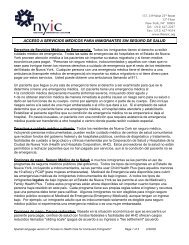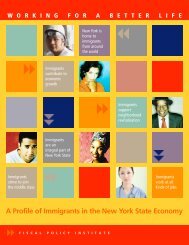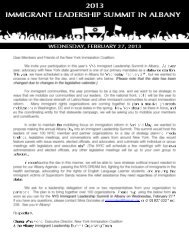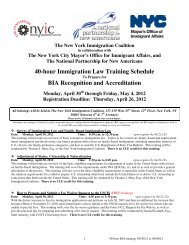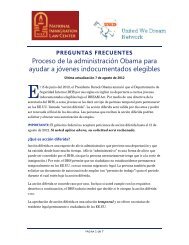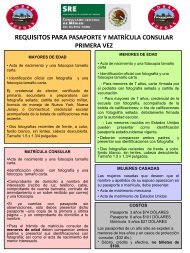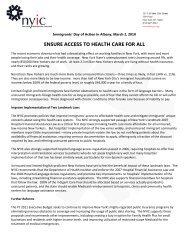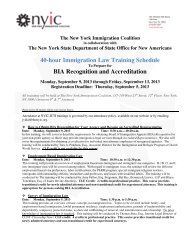Major Legislative Milestones in US Immigration History - New York ...
Major Legislative Milestones in US Immigration History - New York ...
Major Legislative Milestones in US Immigration History - New York ...
Create successful ePaper yourself
Turn your PDF publications into a flip-book with our unique Google optimized e-Paper software.
een new <strong>in</strong>itiatives <strong>in</strong> several European countries (Brita<strong>in</strong>, the Netherlands,and Germany) to create citizenship exams that cover content beyond basic historicalfacts and that capture whether applicants share what are deemed to becore national values. 2Naturalization Trends 1990 to the PresentIn 2004, approximately 38 percent of the foreign-born population (13.1 millionpersons) were naturalized citizens. 3 The rate of naturalization among the foreignbornpopulation has been steadily <strong>in</strong>creas<strong>in</strong>g s<strong>in</strong>ce the early 1990s. Between 1994and 2004, rates of naturalization <strong>in</strong>creased by 232 percent over the previousdecade. 4 This trend has held steady even <strong>in</strong> the face of record <strong>in</strong>creases <strong>in</strong> immigrationlevels dur<strong>in</strong>g the past two decades. A portion of the rise <strong>in</strong> naturalizationss<strong>in</strong>ce 1994 can be attributed to the 1986 <strong>Immigration</strong> Reform and Control Act(IRCA), which granted legal status to 2.7 million unauthorized immigrants, thereby<strong>in</strong>creas<strong>in</strong>g the number of eligible applicants. 5 Other factors that played a role<strong>in</strong> ris<strong>in</strong>g naturalizations <strong>in</strong>clude the exclusion of non-citizens from certa<strong>in</strong> publicbenefits by reforms <strong>in</strong>troduced <strong>in</strong> 1996 and other heightened restrictions (expand<strong>in</strong>gcategories for deportable offenses, e.g.) for the non-naturalized population.Naturalization BacklogsBetween 1997 and 2001, the federal government reported that the average process<strong>in</strong>gtime for <strong>US</strong> naturalization applications decreased from two years to betweensix and n<strong>in</strong>e months. Applications are processed regionally however, and therewere still significant variations <strong>in</strong> process<strong>in</strong>g times due to exist<strong>in</strong>g backlogs. As ofJanuary 2006, district offices <strong>in</strong> Orlando, FL, and Charlotte, NC, were process<strong>in</strong>gnaturalization applications that were submitted <strong>in</strong> December 2004, while offices<strong>in</strong> Providence, RI, and C<strong>in</strong>c<strong>in</strong>nati, OH, were process<strong>in</strong>g applications submittedas recently as October 2005. 6 <strong>US</strong> Citizenship and <strong>Immigration</strong> Services2 Pilot tests have been <strong>in</strong>troduced <strong>in</strong> the Netherlands and <strong>in</strong> Germany that attempt to test the values of applicantsfrom certa<strong>in</strong> countries or religious backgrounds aga<strong>in</strong>st a set of “national values.” As an example, theBaden-Württemberg region of Germany has begun ask<strong>in</strong>g Muslims from Islamic countries an additional set ofquestions to elicit their beliefs on a range of domestic issues <strong>in</strong>clud<strong>in</strong>g women’s rights and religious freedom,to determ<strong>in</strong>e whether they should be granted citizenship. See E. Rothste<strong>in</strong>, “Ref<strong>in</strong><strong>in</strong>g the Tests that ConferCitizenship,” The <strong>New</strong> <strong>York</strong> Times, January 23, 2006.3 A. Erlich and D. Dixon, “Spotlight on Naturalization Trends,” Migration Information Source (Wash<strong>in</strong>gton,DC: Migration Policy Institute, November 1, 2005).4 Ibid.5 Ibid.6 <strong>US</strong> Citizenship and <strong>Immigration</strong> Services Web site, https://egov.immigration.gov/cris/jsps/ptimes.jsp.184S ecur<strong>in</strong>g the Future: <strong>US</strong> Immigrant Integration Policy





